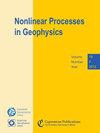一维能量平衡模型的变量技术
IF 1.7
4区 地球科学
Q3 GEOSCIENCES, MULTIDISCIPLINARY
引用次数: 0
摘要
摘要一维气候能量平衡模式(1D EBM)是一种基于地球能量预算的简化气候模式,适用于全球温度带平均分布。我们研究了一类一维气候能量平衡模型,它是与相关变分问题的欧拉-拉格朗日方程相对应的抛物线方程,涵盖了空间不均匀模型,如与纬度相关的反照率模型。我们为至少三个稳态解的存在提供了充分条件,这三个稳态解的形式是两个局部极小值和一个鞍点,即 "寒冷"、"温暖 "和不稳定的 "中间 "气候共存。我们还将最小值解释为与时间相关的随机一维 EBM 的 "典型 "或 "可能 "解。然后,我们研究了作为温室气体浓度函数的目标函数的最小值(在所有温度曲线上)与全球平均温度(也是温室气体浓度函数,即分岔图)之间的联系。具体来说,只要存在唯一的最小化温度曲线,全球平均温度就会连续变化,但同时存在的最小化温度曲线必须具有不同的全球平均温度。此外,全球平均温度随温室气体浓度的变化是不递减的,其跃变必然是向上的。我们还讨论了我们的发现是否适用于更一般的空间异质性反应扩散模型,以及我们的结果的物理解释。本文章由计算机程序翻译,如有差异,请以英文原文为准。
Variational techniques for a one-dimensional energy balance model
Abstract. A one-dimensional climate energy balance model (1D EBM) is a simplified climate model for the zonally averaged global temperature profile, based on the Earth's energy budget. We examine a class of 1D EBMs which emerges as the parabolic equation corresponding to the Euler–Lagrange equations of an associated variational problem, covering spatially inhomogeneous models such as with latitude-dependent albedo. Sufficient conditions are provided for the existence of at least three steady-state solutions in the form of two local minima and one saddle, that is, of coexisting “cold”, “warm” and unstable “intermediate” climates. We also give an interpretation of minimizers as “typical” or “likely” solutions of time-dependent and stochastic 1D EBMs. We then examine connections between the value function, which represents the minimum value (across all temperature profiles) of the objective functional, regarded as a function of greenhouse gas concentration, and the global mean temperature (also as a function of greenhouse gas concentration, i.e. the bifurcation diagram). Specifically, the global mean temperature varies continuously as long as there is a unique minimizing temperature profile, but coexisting minimizers must have different global mean temperatures. Furthermore, global mean temperature is non-decreasing with respect to greenhouse gas concentration, and its jumps must necessarily be upward. Applicability of our findings to more general spatially heterogeneous reaction–diffusion models is also discussed, as are physical interpretations of our results.
求助全文
通过发布文献求助,成功后即可免费获取论文全文。
去求助
来源期刊

Nonlinear Processes in Geophysics
地学-地球化学与地球物理
CiteScore
4.00
自引率
0.00%
发文量
21
审稿时长
6-12 weeks
期刊介绍:
Nonlinear Processes in Geophysics (NPG) is an international, inter-/trans-disciplinary, non-profit journal devoted to breaking the deadlocks often faced by standard approaches in Earth and space sciences. It therefore solicits disruptive and innovative concepts and methodologies, as well as original applications of these to address the ubiquitous complexity in geoscience systems, and in interacting social and biological systems. Such systems are nonlinear, with responses strongly non-proportional to perturbations, and show an associated extreme variability across scales.
 求助内容:
求助内容: 应助结果提醒方式:
应助结果提醒方式:


